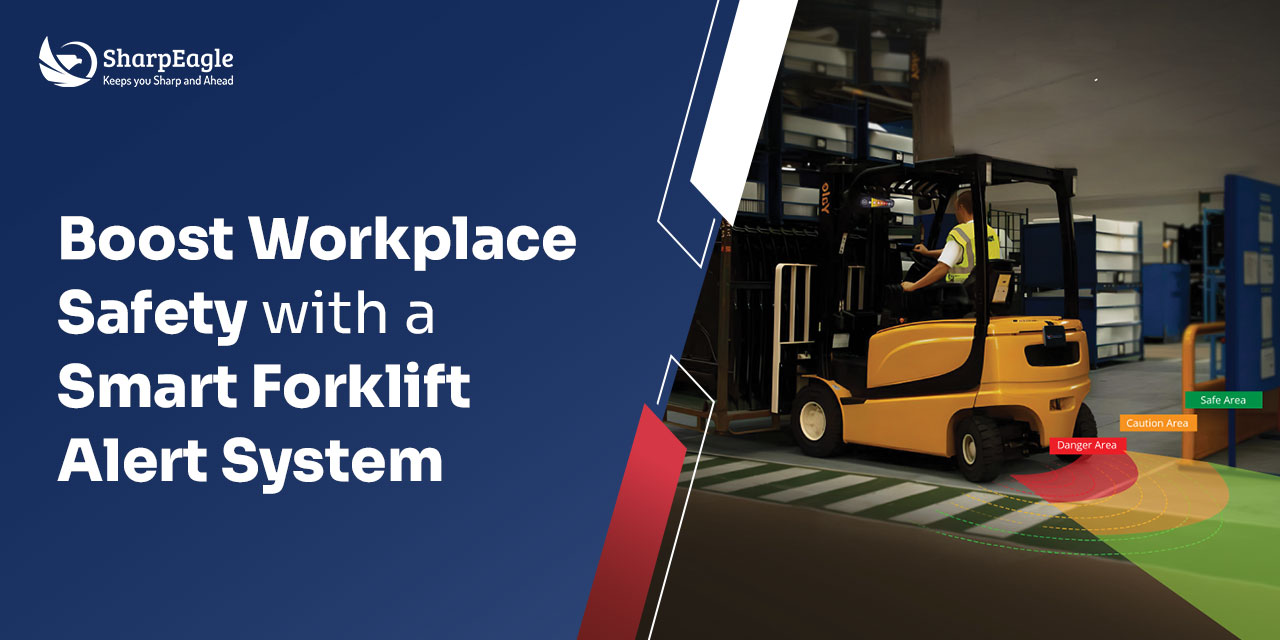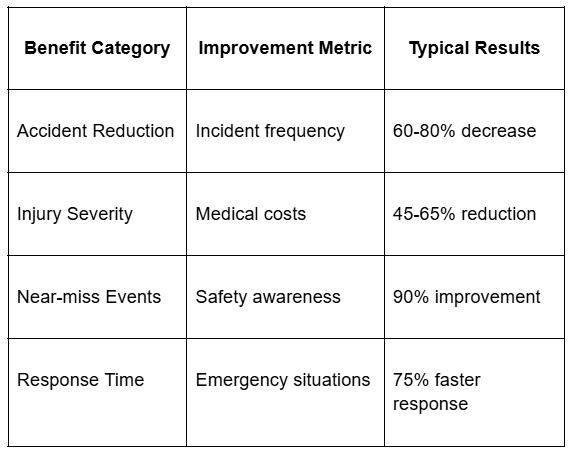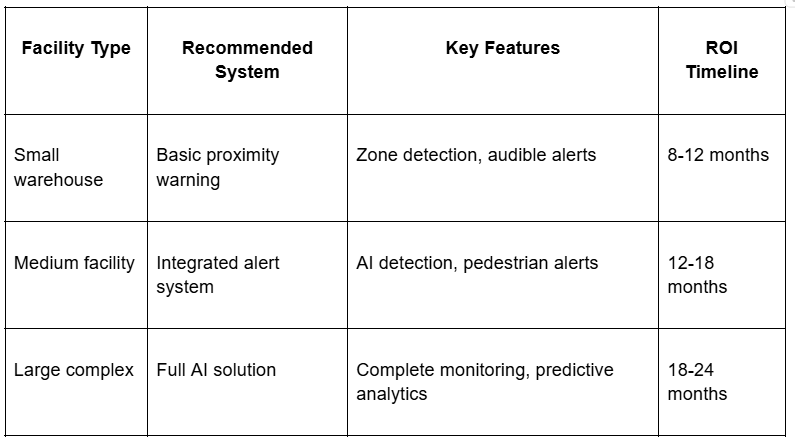

Discover advanced forklift alert systems with AI pedestrian detection, proximity warnings & safety solutions. Reduce accidents by 70% with SharpEagle's smart technology.
Workplace safety in industrial and warehouse environments has never been more crucial as operational complexity and traffic density continue to increase across modern facilities. The intersection of heavy machinery operations with human workers creates inherent risks that demand sophisticated safety solutions and proactive risk management strategies.
The implementation of a comprehensive forklift alert system represents a transformative approach to workplace safety management, providing real-time hazard detection, automated warning protocols, and data-driven safety insights. Modern forklift alert systems integrate advanced technologies including proximity sensors, artificial intelligence, and wireless communication to create multilayered safety protection that significantly reduces accident risks while maintaining operational efficiency.
Beyond immediate safety benefits, forklift alert system implementations demonstrate measurable returns on investment through reduced insurance premiums, decreased downtime, improved regulatory compliance, and enhanced worker confidence. As industrial operations continue evolving toward greater automation and efficiency, intelligent safety systems become essential infrastructure components rather than optional enhancements.
Current statistics reveal the severity of forklift-related incidents, with forklifts causing 67 work-related deaths in 2023 and 24,960 DART cases in 2021-2022. These numbers represent not just statistical data but real human impact affecting workers, families, and entire communities. Perhaps most significantly, OSHA data shows that 70% of forklift accidents are preventable with adequate training and proper safety systems implementation.
Modern warehouse and factory environments present unique challenges that traditional safety measures struggle to address effectively:
These operational realities demand sophisticated forklift warning devices that provide consistent, reliable safety communication regardless of environmental conditions.

A forklift warning system represents an integrated safety solution designed to prevent accidents through real-time hazard detection, automated warning protocols, and intelligent communication between equipment operators and surrounding personnel. These systems combine multiple technologies to create comprehensive safety coverage that addresses the diverse risks present in modern industrial environments.
Proximity sensors that detect nearby objects and personnel within customizable safety zones around operating equipment.
Wireless beacons that establish communication networks between equipment and workers, enabling real-time safety coordination.
Audible and visual alarms that provide immediate hazard warnings through multiple sensory channels for maximum effectiveness.
Central monitoring systems that track safety performance and incident patterns, enabling data-driven safety improvements.
The distinction between proximity warning systems, Pedestrian alert system solutions, and traditional forklift warning devices lies in their sophistication and integration capabilities. Basic warning devices provide simple audio or visual signals, while advanced systems incorporate intelligent detection algorithms, customizable alert protocols, and data analytics capabilities that enable continuous safety improvement.
Modern forklift alert systems incorporate machine learning capabilities that adapt to specific operational environments, learning traffic patterns, identifying high-risk areas, and optimizing alert protocols based on actual usage data. This intelligence enables more effective safety management while reducing false alarms that can lead to warning fatigue among workers.
The evolution of forklift safety technology has produced diverse forklift warning devices designed to address specific operational challenges and safety requirements. Understanding the capabilities and applications of different system types enables informed decision-making when implementing comprehensive safety solutions.
Forklift Proximity Warning systems represent the foundation of modern safety technology, utilizing advanced sensors to detect nearby objects, personnel, and other equipment within defined safety zones. These systems create invisible safety perimeters around operating forklifts, providing graduated alerts as potential hazards approach critical distances.
Key Features:
The technology operates through sophisticated sensor arrays that continuously monitor the environment around moving equipment, distinguishing between stationary objects, moving personnel, and other equipment to provide appropriate warning responses.
Pedestrian alert system technology focuses specifically on protecting workers who operate in areas where forklifts are active, providing personal warning devices that communicate directly with approaching equipment. These systems ensure workers receive immediate notification when forklifts enter their operational area, regardless of ambient noise levels or visual obstructions.
Modern Pedestrian alert system implementations utilize wearable devices that:
AI Pedestrian Detection represents the cutting edge of forklift safety technology, utilizing artificial intelligence and computer vision to identify and track human presence in real-time operational environments. This technology provides unprecedented accuracy in distinguishing between humans, equipment, and stationary objects, enabling precise safety responses tailored to specific hazard types.
AI Pedestrian Detection systems operate through advanced camera networks that continuously analyze visual data using machine learning algorithms trained to recognize:
The real-time processing capabilities enable immediate response to developing safety situations, with automatic alerts, equipment slowdown protocols, and emergency braking capabilities when integrated with forklift control systems.
The implementation of comprehensive forklift alert systems delivers measurable benefits that extend far beyond basic accident prevention, creating value through improved operational efficiency, regulatory compliance, and enhanced workplace culture.

Reduces Accidents and Injuries: With 70% of forklift accidents being preventable through proper safety measures, intelligent alert systems provide the proactive protection necessary for significant incident reduction. Statistical analysis of facilities implementing comprehensive alert systems shows accident reduction rates of 60-80%, with corresponding decreases in injury severity and associated costs.
Enhances Operator Awareness: Forklift alert systems augment human capabilities by providing continuous environmental monitoring that exceeds natural sensory limitations. Operators benefit from 360-degree hazard detection, blind spot elimination, and proximity warnings that enable informed decision-making in complex operational environments.
Improves Compliance with Safety Regulations: Modern forklift alert systems facilitate compliance with OSHA regulations and industry safety standards by providing documented safety protocols, automated monitoring capabilities, and comprehensive incident reporting.
Minimizes Downtime and Costs: Accident prevention eliminates the operational disruptions associated with incident response, equipment damage repair, and regulatory investigations. The proactive safety approach reduces insurance premiums, workers' compensation costs, and liability exposure.
Boosts Worker Confidence and Morale: Employees operating in environments protected by comprehensive forklift alert systems report increased confidence and job satisfaction, knowing their employer prioritizes worker safety through advanced technology investments.
The integration of artificial intelligence in forklift safety represents a paradigm shift from reactive safety measures to proactive, intelligent hazard prevention systems. AI Pedestrian Detection technology has emerged as a transformative solution that addresses the limitations of traditional safety approaches while providing unprecedented accuracy and reliability in hazard identification.
Object Recognition Technology: AI systems identify pedestrians in blind spots, distinguish between humans and equipment, and analyze movement patterns to predict potential collision scenarios. The technology operates continuously without fatigue or distraction, providing consistent safety monitoring regardless of environmental conditions.
Real-time Processing: AI Pedestrian Detection systems process visual data from multiple camera sources to create comprehensive situational awareness that exceeds human capabilities. Machine learning algorithms continuously improve performance through operational experience and environmental adaptation.
Predictive Safety Management: Advanced AI systems can analyze historical data and current conditions to predict high-risk scenarios, enabling preventive measures before dangerous situations develop.
Automated Response Protocols: When integrated with forklift control systems, AI detection enables graduated responses from gentle warnings to emergency stops based on the severity and immediacy of detected hazards.
The regulatory landscape for forklift safety is governed primarily by OSHA standards, specifically 29 CFR 1910.178 for general industry and 29 CFR 1926.602 for construction environments. OSHA requires that all new powered industrial trucks meet the design and construction requirements established in the American National Standard for Powered Industrial Trucks.
Training and Certification: OSHA mandates that all forklift operators must be trained and certified, with retraining necessary after incidents, observed unsafe behavior, changes in workplace conditions, or assignment to a new type of forklift.
Equipment Standards: All forklift safety equipment must meet established industry standards and undergo regular inspection and maintenance to ensure continued effectiveness.
Documentation Requirements: Organizations must maintain comprehensive records of safety training, equipment maintenance, incident reports, and safety system performance to demonstrate regulatory compliance.
Risk Assessment: Regular workplace safety assessments must identify potential hazards and implement appropriate safety measures, including advanced alert systems where necessary.
SharpEagle Technology stands at the forefront of workplace safety innovation, leveraging decades of experience in industrial safety solutions to develop comprehensive forklift alert systems that address the complex challenges of modern operational environments.
Our AI Forklift CCTV Solutions provide real-time monitoring capabilities that eliminate blind spots and enable comprehensive situational awareness through intelligent video analysis. These systems incorporate advanced AI Pedestrian Detection algorithms that distinguish between personnel, equipment, and stationary objects while providing continuous safety monitoring.
SharpEagle's proximity warning solutions ensure safe distance maintenance through sophisticated sensor technologies:
Our Pedestrian alert system solutions include specialized lighting technologies:
A major distribution center implemented SharpEagle's comprehensive safety solution combining AI CCTV monitoring, proximity warning devices, and pedestrian alert systems. The installation resulted in a 78% reduction in safety incidents within the first six months, with corresponding improvements in operational efficiency and worker confidence.
Selecting the appropriate forklift alert systems requires comprehensive analysis of operational requirements, environmental conditions, and specific safety challenges present in your facility.

AI-driven Accuracy: Precise hazard detection with minimal false alarms, maintaining operational efficiency while maximizing safety protection through machine learning algorithms that continuously improve performance.
Rugged Industrial Design: Reliable performance in harsh operational environments, with weather-resistant construction, vibration tolerance, and extended operational life that minimizes maintenance requirements.
Easy Integration: Seamless connectivity with existing warehouse operations, eliminating disruption during installation while providing compatibility with current safety systems and facility management platforms.
Proven ROI: Measurable financial returns through accident reduction and efficiency improvement, with customers reporting average payback periods of 12-18 months through reduced insurance costs and improved productivity.
Successful implementation of forklift warning devices requires systematic planning, comprehensive preparation, and ongoing management to ensure maximum safety effectiveness and operational integration.
Phase 1: Assessment and Planning
Phase 2: System Selection and Design
Phase 3: Installation and Testing
Phase 4: Training and Deployment
Regular Maintenance: Implement preventive maintenance programs including sensor calibration, software updates, performance testing, and component replacement schedules.
Performance Monitoring: Track system effectiveness through safety metrics, incident analysis, and user feedback to identify improvement opportunities.
Continuous Training: Provide ongoing education for new employees and refresher training for existing staff to ensure proper system utilization.
System Updates: Stay current with technology improvements and regulatory changes that may require system modifications or enhancements.
The adoption of smart forklift alert systems represents a critical investment in worker protection and operational excellence that delivers measurable benefits through accident prevention, regulatory compliance, and enhanced productivity. As industrial operations continue evolving toward greater complexity and efficiency demands, intelligent safety systems become essential infrastructure components rather than optional enhancements.
SharpEagle's comprehensive safety solutions combine proven AI innovation with practical safety measures that address real-world operational challenges while providing measurable return on investment. Our integrated approach to forklift alert systems creates multilayered protection that significantly exceeds traditional safety approaches while maintaining operational efficiency.
Ready to make your workplace safer? Contact SharpEagle today to explore advanced forklift alert systems and AI-powered safety solutions tailored for your operations. Our expert team provides comprehensive consultation, customized system design, and ongoing support to ensure maximum safety effectiveness and operational integration.
Transform your facility's safety performance through proven technology solutions that protect workers, reduce costs, and enhance operational efficiency. Schedule your safety assessment today and discover how SharpEagle's intelligent forklift alert systems can revolutionize workplace safety in your operation.
What is the warning system for forklifts?
A forklift warning system is a comprehensive safety solution that combines sensors, alarms, and communication technologies to detect potential hazards and alert operators and pedestrians to dangerous situations. Modern systems integrate proximity sensors, visual alerts, audible warnings, and AI-powered detection capabilities to provide multilayered safety protection.
How do forklift warning devices work?
Forklift warning devices operate through various technologies including ultrasonic sensors, radar detection, camera systems, and wireless communication networks. These devices continuously monitor the environment around operating forklifts, detecting nearby personnel or obstacles and triggering appropriate warning responses ranging from gentle alerts to emergency stops.
What role does AI pedestrian detection play in forklift safety?
AI Pedestrian Detection revolutionizes forklift safety by providing intelligent analysis of operational environments, distinguishing between humans and objects with unprecedented accuracy. This technology enables predictive safety management, automatic emergency responses, and comprehensive situational awareness that significantly exceeds traditional safety measures.
Can forklift alert systems help meet OSHA safety standards?
Yes, forklift alert systems support OSHA compliance by providing documented safety protocols, automated hazard detection, and comprehensive incident reporting. These systems demonstrate due diligence in workplace safety management while generating the documentation necessary for regulatory compliance and safety audits.
What is the pedestrian warning system for forklifts?
A Pedestrian alert system for forklifts consists of wearable devices and warning technologies that alert workers when forklifts are operating in their area. These systems use wireless communication, vibrating alerts, and visual warnings to ensure pedestrians receive immediate notification of potential hazards regardless of environmental conditions.
What are the pedestrian rules for forklifts?
Pedestrian safety rules for forklift operations include maintaining designated walkways, wearing high-visibility clothing, avoiding forklift operational areas when possible, following facility traffic patterns, and responding immediately to forklift warnings. Forklift alert systems support these rules by providing consistent hazard communication and automated safety monitoring.



